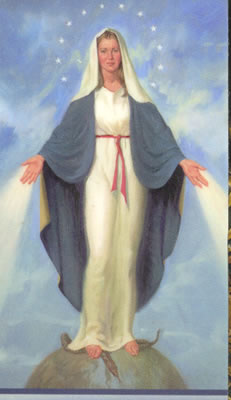
How does
the Virgin Mary fit into all this?
Evan's theory:
WSJ 5/13/10---Pope
Benedict XVI traveled to the Catholic shrine of Fatima to mark the date the
Virgin first appeared there--May 13, 1917, and the assassination attempt on
Pope John Paul II on May 13, 1981. John Paul believed the Virgin's "unseen
hand" had "rescued him from death in the assassination attempt".
John Paul gave the bullet that was extracted from his abdomen to the Fatima
shine, it is now mounted as part of the Virgin's gold crown on her statue at
Fatima.
Evan notes this is a strong endorsement of Her protection
capabilities.
I recently
discovered that Athena's birthday (Panathenaia) and the
Assumption of the Virgin Mary are the same day--August 15th.
The great festival was performed every four years
from 570 BCE onward, though there were yearly "small" Panathenaias
as well. The date was the twenty-eighth day of the month Hekatombaion (mid-July
to mid-August). See http://www.bookrags.com/research/panathenaia-eorl-10/
For hundreds of years, Catholics observed the
feast of the Assumption of the Blessed Virgin Mary on August 15..See
http://wf-f.org/Assumption.html
As Mary became Queen of Heaven, She assumed some of Athena's roles--
Biblical
passages as in Revelation XII: 1-2, where the pregnant Divine Mother Sophia
appears in heaven “robed with the sun, beneath her
feet the moon, and on her head a crown of twelve stars”.
Rev. XII: 5 goes on to say: “She gave birth to a
male child”.

Mary as appears on the Miraculous Medal
"...insamuch
as God, by one and the same decree, had established the origin of Mary and the
Incarnation of Divine Wisdom."
Pope Pius IX- Bull Ineffabilis- 1854
The Divine
Wisdom was incarnate in the Virgin Mary.
Athena was
the Goddess of Wisdom.
626 CE- MIRACLE
SAVES CONSTANTINOPLE-
Due to the intercession
of the Theotokos (Virgin Mary), the city is saved. "While the Emperor of
Byzantium Heracleios was on an expedition to fight the aggression of the Persians
on their own grounds, there appeared outside the walls of Constantinople barbaric
hordes, mostly Avars. The siege lasted a few months, and it was apparent that
the outnumbered troops of the Queen City were reaching desperation. However
as history records, the faith of the people worked the impossible. The Venerable
Patriarch Sergius with the Clergy and the Official of Byzantium Vonos, endlessly
marched along the great walls of Constantinople with an Icon of the Theotokos
in hand, and bolstered the faith of the defenders of freedom. The miracle came
soon after. Unexpectedly, as the chronicler narrates, a great storm with huge
tidal waves destroyed most of the fleet of the enemy, and full retreat ensued.
The faithful
of Constantinople spontaneously filled the Church of the Theotokos at Vlachernae
on the Golden Horn, and
with the Patriarch Sergius officiating, they prayed all night singing praises
to the Virgin Mary without sitting. Hence the title of the
Hymn "Akathistos", in Greek meaning 'not seated'.
The Akathist Hymn to the Theotokos-
Unto
you, O Theotokos, invincible Champion, your City, in thanksgiving ascribes the
victory for the deliverance
from sufferings. And having your might unassailable, free us from all dangers,
so that we may cry unto you:
Rejoice, O Bride Ever-Virgin.
Rejoice,
Vessel of the Wisdom of God. Rejoice, Treasury of His providence. "
Here is Theotokos
performing in Athena fashion to protect Constantinople. In the Akathist Hymn,
Theotokos (Virgin Mary) is described as an "invincible Champion" with
"might unassailable" who saves the city. She is the "Vessel of
the Wisdom of God". The Virgin Mary is assuming Athena's role in protecting
the city.
(See footnote 1)
630 CE- ATHENA'S TEMPLE
NAMED AFTER DIVINE WISDOM--
"The
most important symbol of Greek heathenism, the Parthenon, was changed in the
seventh century into a church for Aghia Sophia, the divine wisdom..."
(see footnote 2)
This shows beyond any doubt that the Christian Church
linked Divine Wisdom to Athena.
"It is by no means coincidence that the chief temples
of Pagan Athens and Christian Constantinople were both dedicated to Wisdom.
The Parthenon as the shrine of the Goddess Athena, Goddess of Wisdom, and Justinian's
Great Church both showed respect for "Sophia" which has always been
one of the chief traits of the Greek mind."
(see footnote 3)
Footnote 1 (Divine Sevices & Hymns---Akathist Hymn)
http://www.orthodoxchristian.info/pages/main.htm
Footnote 2 (para 2)
http://monolith.dnsalias.org/~marsares/acro/history/medieval.html
Footnote 3 (see "The Church of St. Sophia")
http://www.greece.org/Romiosini/constple.html